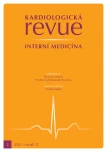Acute conditions in medicine of thyroid gland
Authors:
J. Jiskra
Authors‘ workplace:
3. interní klinika 1. LF UK a VFN v Praze
Published in:
Kardiol Rev Int Med 2015, 17(2): 172-177
Category:
Internal Medicine
Overview
Acute conditions in medicine of thyroid gland include thyroid storm, myxoedema coma, acute hypocalcaemia following thyroid surgery, imminent suffocation and superior vena cava syndrome in rapidly growing goitre, sight- threatening Graves’ ophthalmopathy and acute purulent thyroiditis and its complications (acute mediastinitis and sepsis). As these are rare conditions, the management is often not fully evidence based and is rather empirical and based on pathophysiological principles. Thyroid storm is treated with intravenous methimazole, hydrocortisone and beta‑blockers, myxoedema coma with hydrocortisone and high‑dose levothyroxine and in individual cases in combination with triiodothyronine. In acute postoperative hypocalcaemia, calcium must be supplemented intravenously or orally (in mild cases) and if hypoparathyroidism is confirmed, calcitriol should be added. Rapidly growing goitre often has malignant etiology and when the fine needle aspiration biopsy is not diagnostic, material for purpose of histological examination must be obtained and only after that corticosteroids may be administered. The patient with sight- threatening Graves’ ophthalmopathy must be immediately referred to a “thyroid eye centre”. Fine needle aspiration biopsy with bacteriological examination of the obtained sample is the first step in the management of a patient with acute purulent thyroiditis followed by systemic antibiotic treatment, abscess evacuation and drainage and intensive care if needed (sepsis).
Keywords:
thyroid storm – myxoedema coma – hypocalcaemia – hypoparathyroidism – anaplastic thyroid cancer – thyroid lymphoma – sight- threatening Graves’ ophthalmopathy – acute purulent thyroiditis
Sources
1. Burch HB, Wartofsky L. Life- threatening hyperthyroidism: thyroid storm. Endocrinol Metab Clin North Am 1993; 22: 263– 277.
2. Bahn RS, Burch HB, Cooper DS et al. Hyperthyroidism and other causes of thyrotoxicosis: management guidelines of the American Thyroid Association and American Association of Clinical Endocrinologists. Endocr Pract 2011; 17: 456– 520.
3. Jonklaas J, Bianco AC, Bauer AJ et al. Guidelines for the treatment of hypothyroidism. Thyroid 2014; 24: 1670– 1751. doi: 10.1089/ thy.2014.0028.
4. Yamamoto T, Fukuyama J, Fujiyoshi A. Factors associated with mortality of myxedema coma: report of eight cases and literature survey. Thyroid 1999; 9: 1167– 1174.
5. Vlček P, Neumann J. Karcinom štítné žlázy. Pooperační sledování nemocných. Praha: Maxdorf 2002: 218.
6. Brunaud L, Zarnegar R, Wada N et al. Incision length for standard thyroidectomy and parathyroidectomy: he is it minimaxy invasive? Arch Surg 2003; 138: 1140– 1143.
7. Dvořák J, Kubín S, Schuster J. Chirurgie štítné žlázy. Postgraduální medicína 2002; 4: 597– 603.
8. Paes JE, Burman KD, Cohen J et al. Acute bacterial suppurative thyroiditis: a clinical review and expert opinion. Thyroid 2010; 20: 247– 255. doi: 10.1089/ thy.2008.0146.
9. Farwell AP. Infectious thyroiditis. In: Braverman LE, Utiger RD (eds). Werner and Ingbar’s The Thyroid. 8th ed. Philadelphia: Lippincott, Williams and Wilkins 2000: 1044– 1149.
Labels
Paediatric cardiology Internal medicine Cardiac surgery CardiologyArticle was published in
Cardiology Review

2015 Issue 2
Most read in this issue
- Clinical classification and scoring systems in heart failure
- Scoring systems for venous thromboembolic disease
- Differential diagnosis of hyponatraemia
- Acute conditions in medicine of thyroid gland
